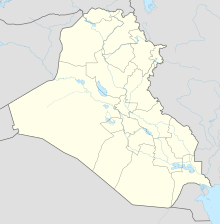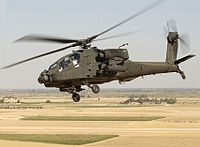This article needs additional citations for verification. (December 2017) |
| 2003 attack on Karbala | |||||||
|---|---|---|---|---|---|---|---|
| Part of the invasion phase of the Iraq War | |||||||
| |||||||
| Belligerents | |||||||
| |||||||
| Commanders and leaders | |||||||
|
|
| ||||||
| Strength | |||||||
| 31 AH-64 Apaches |
90 tanks[2] Several hundred vehicles | ||||||
| Casualties and losses | |||||||
|
1 Apache crashed after takeoff 1 Apache shot down 29 Apaches damaged At least 1 wounded 2 pilots captured[3] |
12 tanks 6 S-60 AA guns[4] | ||||||
Location of Karbala within Iraq. | |||||||
The 2003 attack on Karbala was an unsuccessful strike on the Iraqi Republican Guard's Medina Division by the U.S. 3rd Infantry Division during the 2003 invasion of Iraq. The Medina Division was mostly deployed along the Karbala gap, west of the city of Karbala itself. The Iraqi division was targeted as it was the best equipped Iraqi unit, and its destruction would negatively affect Iraqi military morale. The Medina Division sustained only limited damage during the engagement.
The defeat for the Americans resulted in one AH-64 Apache being shot down intact. The two pilots were captured and shown on television along with the helicopter.[5] Pentagon officials stated the captured Apache was destroyed via airstrike the following day,[6][7] Iraqi officials claimed a farmer named Ali Ubaid Mankash with a czech-made Brno rifle shot down the Apache. After the invasion, the farmer denied any involvement.[8]
- ^ Allied Participation in Operation Iraqi Freedom by Stephe Carney
- ^ a b "U.S. Apache Pilots Taken Prisoner". CNN. 24 March 2003.
- ^ Cite error: The named reference
addpagewas invoked but never defined (see the help page). - ^ Bernstein, p. 51
- ^ "Iraq shows off Apache crew". BBC News. 2003-03-25. Retrieved 2010-07-31.
- ^ "Downed Apache Blown Up To Keep Secrets From Iraq". Evening Times. 25 March 2003. Archived from the original on 7 November 2012. Retrieved 5 July 2017.
- ^ "Downed US Apache Blown Up With Missile". New Straits Times. 26 March 2003.
- ^ "The 'Apache' farmer's tale". BBC News. 2003-04-23. Retrieved 2010-07-31.



